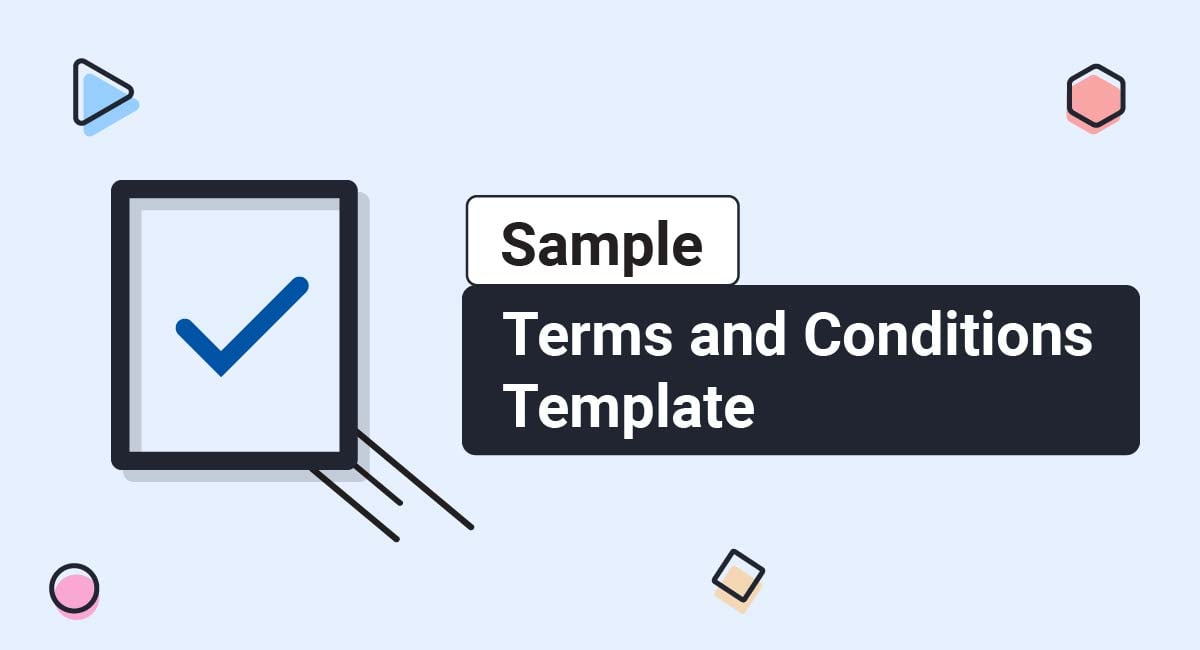

A Terms and Conditions agreement is where you let the public know the terms, rules and guidelines for using your website or mobile app. They include topics such as acceptable use, restricted behavior and limitations of liability.
This article will get you started with creating your own custom Terms and Conditions agreement. We've also put together a Sample Terms and Conditions Template that you can use to help you write your own.
Our Terms and Conditions Generator makes it easy to create a Terms and Conditions agreement for your business. Just follow these steps:
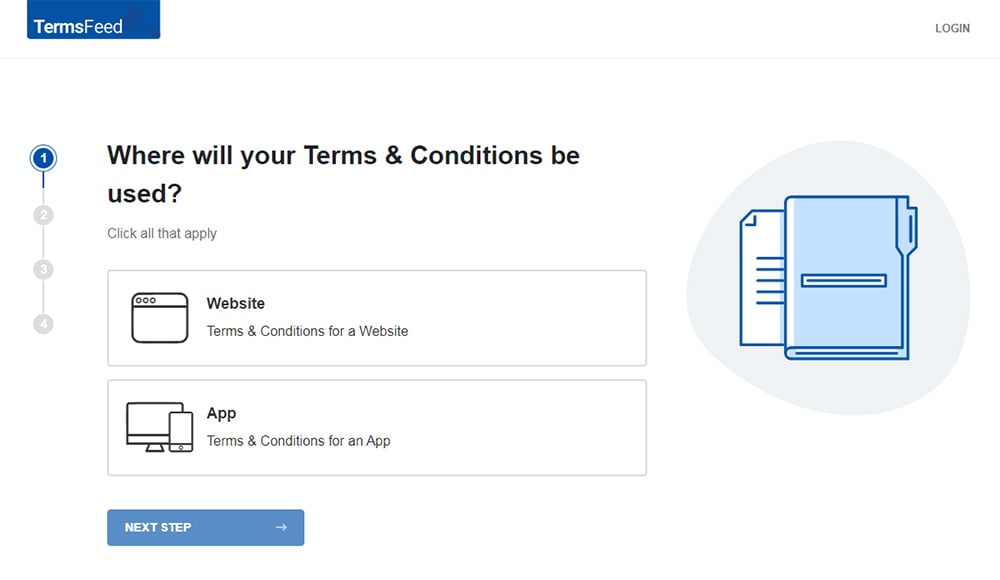
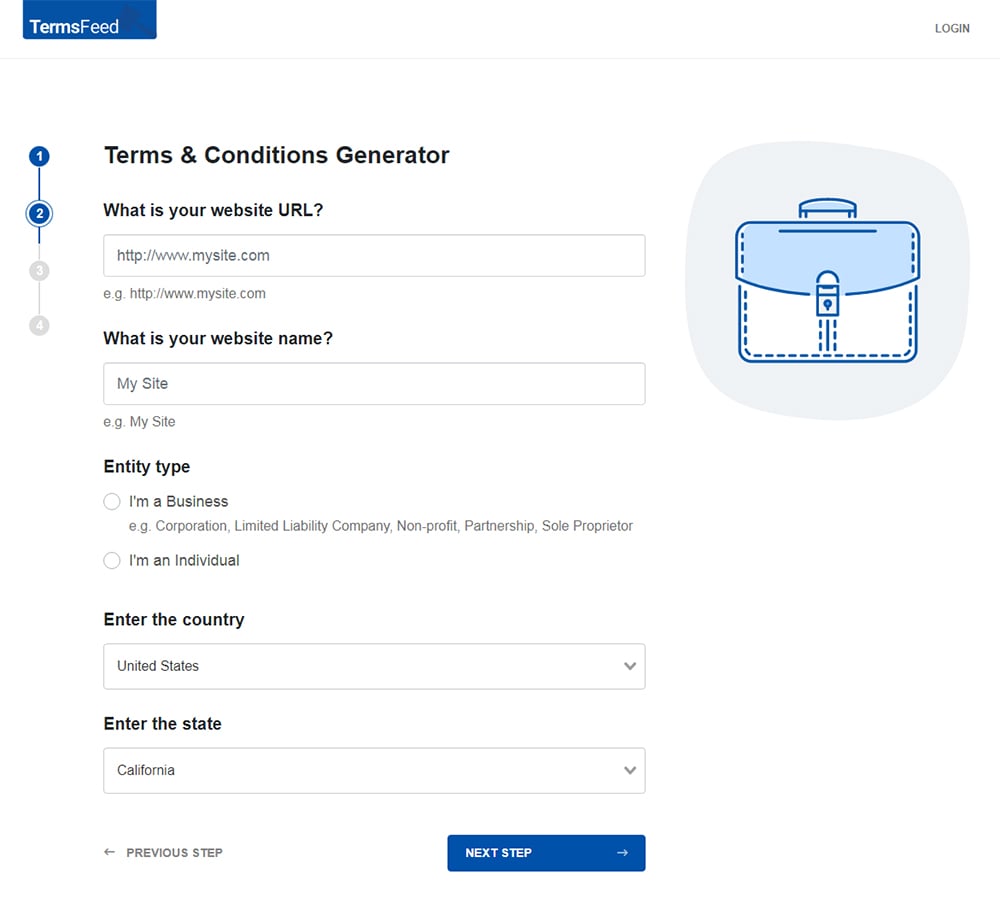
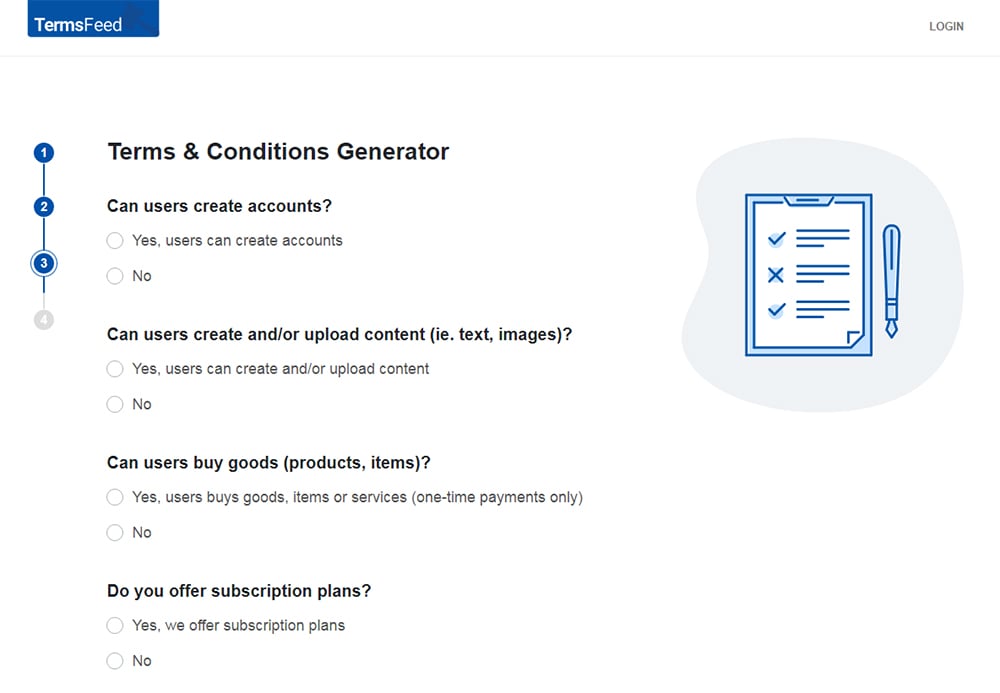
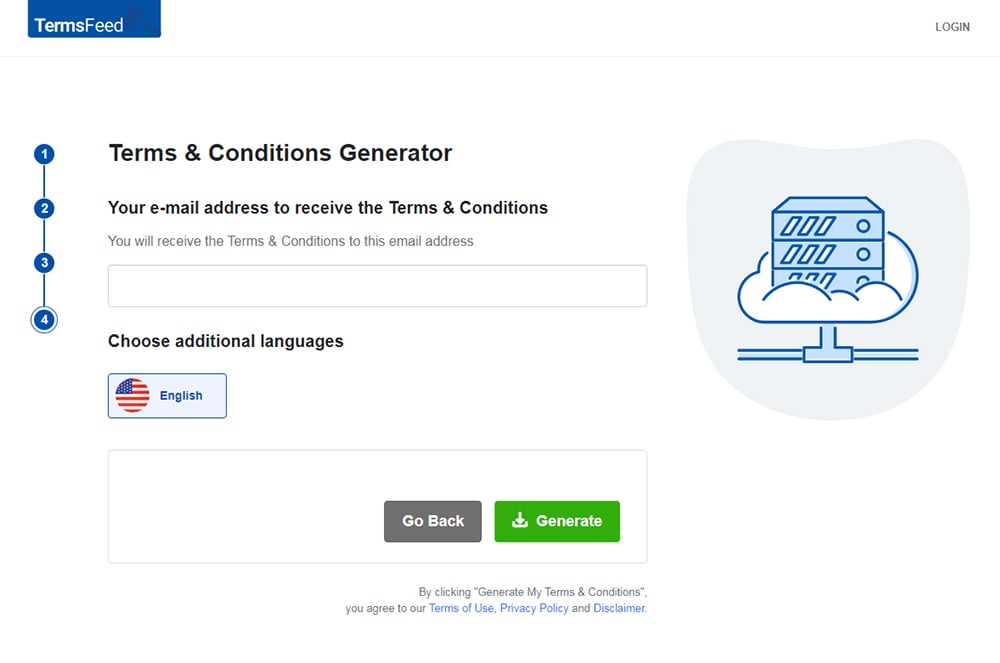 You'll be able to instantly access and download the Terms & Conditions agreement.
You'll be able to instantly access and download the Terms & Conditions agreement.A Terms and Conditions agreement acts as a legal contract between you (the company) and the user. It's where you maintain your rights to exclude users from your app in the event that they abuse your website/app, set out the rules for using your service and note other important details and disclaimers.
Having a Terms and Conditions agreement is completely optional. No laws require you to have one. Not even the super-strict and wide-reaching General Data Protection Regulation (GDPR).
Your Terms and Conditions agreement will be uniquely yours. While some clauses are standard and commonly seen in pretty much every Terms and Conditions agreement, it's up to you to set the rules and guidelines that the user must agree to.
Terms and Conditions agreements are also known as Terms of Service or Terms of Use agreements. These terms are interchangeable, practically speaking. More rarely, it may be called something like an End User Services Agreement (EUSA).
Check out our Terms and Conditions FAQ article for more helpful insight into these important agreements.
You can use this agreement anywhere, regardless of what platform your business operates on:
Desktop apps usually have an EULA (End-User License Agreement) instead of a Terms and Conditions agreement, but your business can use both. Mobile apps are increasingly using Terms and Conditions along with an EULA if the mobile app has an online service component, i.e. it connects with a server.
What's a Terms and Conditions Agreement from termsfeedA Terms and Conditions is not required and it's not mandatory by law.
Unlike Privacy Policies, which are required by laws such as the GDPR, CalOPPA and many others, there's no law or regulation on Terms and Conditions.
However, having a Terms and Conditions gives you the right to terminate the access of abusive users or to terminate the access to users who do not follow your rules and guidelines, as well as other desirable business benefits.
It's extremely important to have this agreement if you operate a SaaS app.
Here are a few examples of how this agreement can help you:
In summary, while you do not legally need a Terms and Conditions agreement, there are many many reasons for you to have one. Not only will it make your business look more professional and trustworthy, but you'll also be maintaining more control over how your users are able to interact with your platforms and content.
In your Terms and Conditions, you can include rules and guidelines on how users can access and use your website and mobile app.
Here are a few examples:
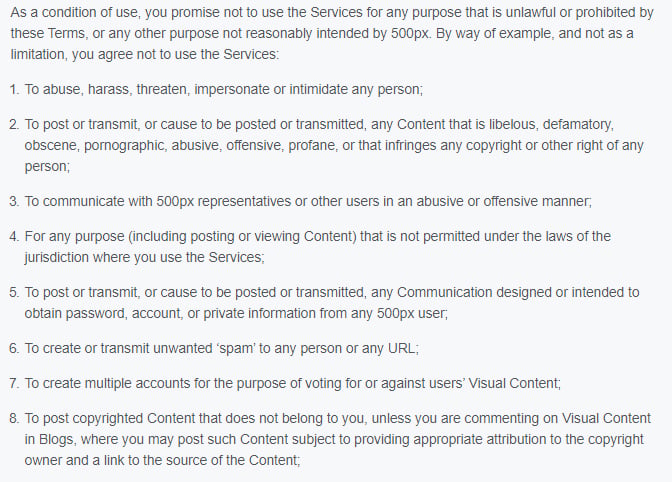
You can also use your T&C to inform users about trademarks, design rights and other intellectual property rights:

If you operate a SaaS app, a "Termination clause" will be very important. The relationship with your customers can end for any number of reasons, from a customer changing careers to a new and better SaaS option becoming available or just general dissatisfaction with a service.
But as the owner of the app, you should have a way to actively end a relationship with a customer under certain circumstances.
SurveyMonkey has included sections in its Terms of Use that outlines what happens in the event of termination of service by either party. First, here's how users can terminate accounts and what the result of this will be:
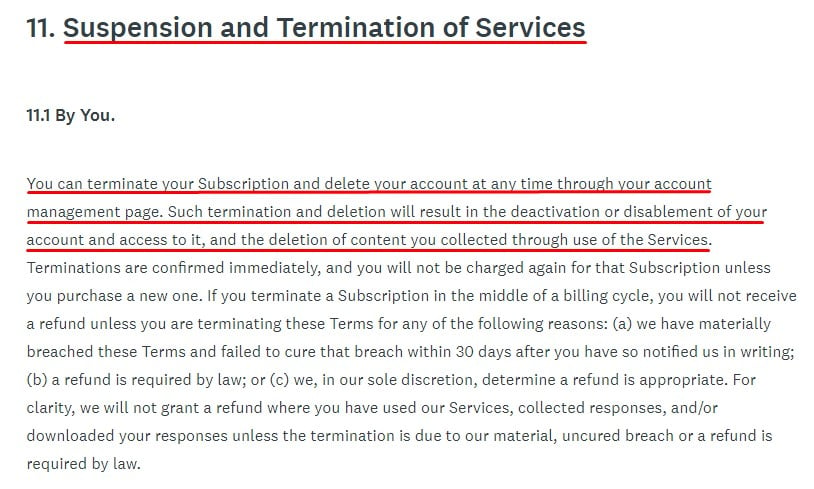
And here's how the company retains the right to terminate accounts, either for explicit violations of the Terms, or for any reason the company deems fit:
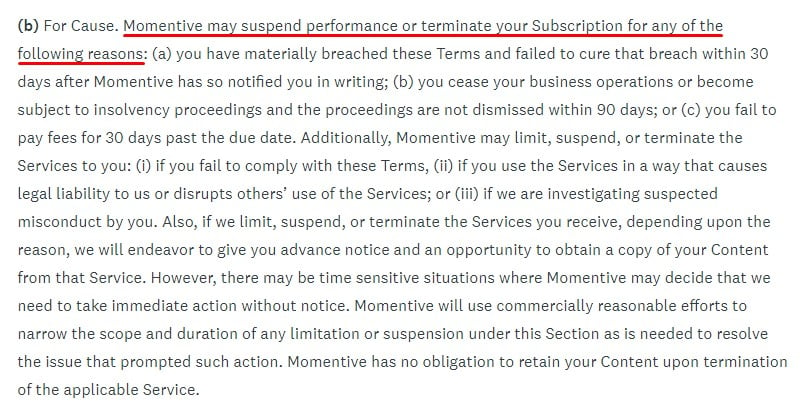
If you sell products (physical or digital), you'll want Terms and Conditions for your store. Having this agreement in place will help you:
Let's look at an example: the Limitation of Liability of Your Products clause.
No matter what kind of goods you sell, best practices direct you to present any warranties you are disclaiming and liabilities you are limiting in a way that your customers will notice.
You've probably noticed that these clauses in contracts are always in blocks of all-caps text and really do stand out from the rest of the document.
Apple iTunes, which probably isn't dealing with high-liability goods, includes the following boilerplate language in its Terms agreement to deal with limiting liability and disclaiming warranties.
This exact language is used across multiple industries, businesses, and apps in order to legally disclaim warranties and limit liability.
Include the words "AS IS" for items and "AS AVAILABLE" if you provide any sort of service that may not be available 100% of the time.
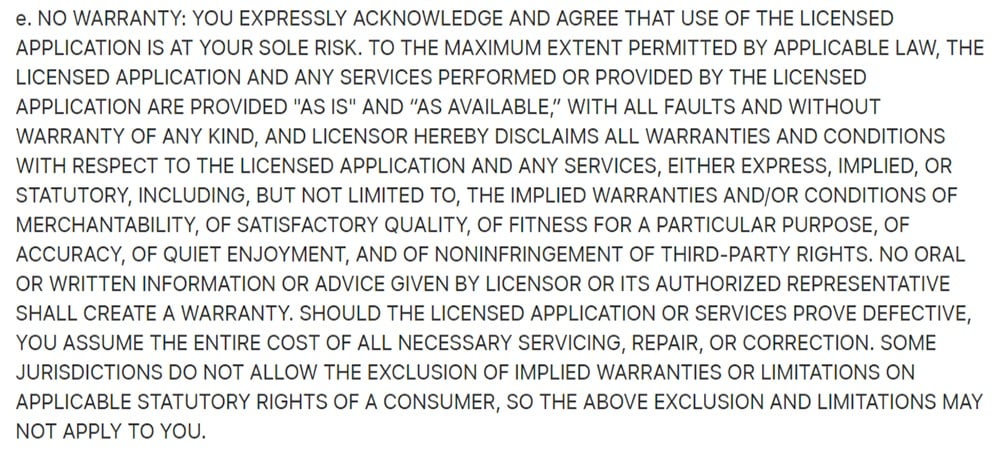
Here's a list of questions that can help you determine what to add in your own Terms and Conditions agreement:
You should always use clickwrap to get users to agree to your Terms and Conditions. Clickwrap is when you make your users take some action - typically clicking something - to show they're agreeing.
Here's how Equifax does this. Users cannot continue with creating an account until clicking the box that shows they agree to the Terms:
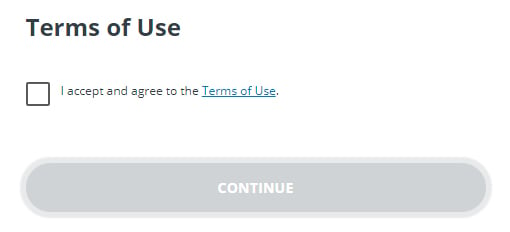 accept and agree to Terms of Use - unchecked" width="510" height="232" />
accept and agree to Terms of Use - unchecked" width="510" height="232" />
Creating a Terms and Conditions agreement is quite simple. After you have your agreement created, make sure to display it somewhere where people can easily find and access it at any time.
And don't forget to make sure you get agreement to your terms from anyone who signs up for an account with your website, downloads your mobile app, makes a purchase, signs up for a subscription or in any other way becomes connected to your business.
Here is a list of frequently asked questions that you may find useful.
A Terms and Conditions agreement is not legally required. However, having one comes with a number of important benefits for both you and your users/customers.
The benefits include increasing your control over your business/platform, while helping your users understand your rules, requirements and restrictions.
The main benefit of having a Terms and Conditions agreement is that you maintain the highest level of control over your website/business.
Your Terms and Conditions agreement is where you're able to list your rules when it comes to the use of your website. You're also able to maintain the right to terminate abusive accounts, disclaim warranties and limit your liability.
There are benefits for your users, as well. Your Terms and Conditions agreement makes it clear to your users what you expect from them, what they are not allowed to do with your website/service, and how they must handle certain situations such as arbitration and canceling their own accounts.
Without a Terms and Conditions agreement, your rules and requirements won't be made public and provided to your users. This means your users may take advantage of your "lawless" platform.
You may also get bombarded with questions from users asking about things that would otherwise be included in your Terms and Conditions agreement. For example, you may get a lot of questions asking how you handle user-generated content rights, or how a user can shut down an account.
Some clauses are specific to certain types of businesses and won't be found in all Terms and Conditions agreements. For example, you won't need a clause about subscription payment terms if you don't offer paid subscriptions.
In general, almost every Terms and Conditions agreement should include the following clauses:
The more complicated your website or business is, the more clauses you will end up having.
Some business-specific clauses include the following:
Display your Terms and Conditions agreement in the following places, where applicable:
The key here is to make sure your Terms and Conditions agreement is always accessible at any time, and that you also provide it additionally at points where the user may be more interested in referring to its terms.
Adding a link to your website footer or within your app menu makes your Terms and Conditions agreement available at any and all times. Adding a link to times when a user is interacting with you in a more specific way, such as when creating an account or placing an order, helps remind the user about your Terms and Conditions agreement at that important time.
To make your Terms & Conditions agreement enforceable, place an un-ticked checkbox next to a link to your agreement and a statement that says something along the lines of, "By checking this box, you agree to be bound by our Terms and Conditions agreement."
You can also use an "I Agree" button instead of a checkbox that users must click to show they agree to your Terms and Conditions agreement.
Here's how The Guardian is placing the link to its Terms and Conditions agreement at the bottom of its webpages:
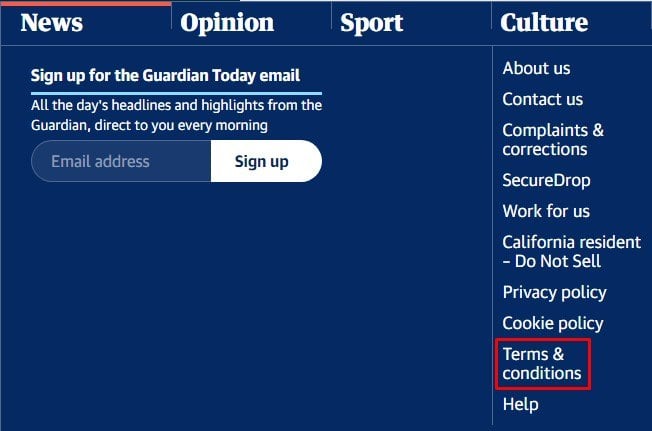
The legal page is simple and follows the design of The Guardian's website. But the agreement is lengthy and it has multiple clauses that are useful for The Guardian:
The Terms and Conditions includes a short introduction that helps set the stage for the rest of the content.
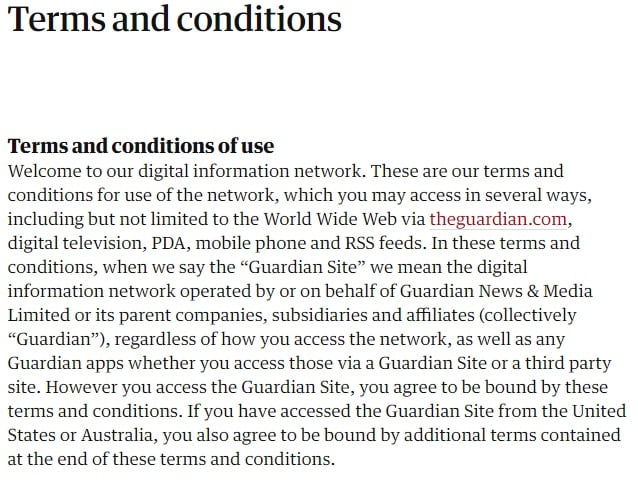
KAYAK also places a link to its Terms and Conditions in the footer:

The first paragraph of KAYAK's agreement is very clear for users:
Please read these terms and conditions of use carefully before accessing, using or obtaining any materials, information, products or services. By accessing the KAYAK website, mobile or tablet application, or any other feature or other KAYAK platform (collectively "Our Website") you agree to be bound by these terms and conditions ("Terms") and our Privacy Policy.
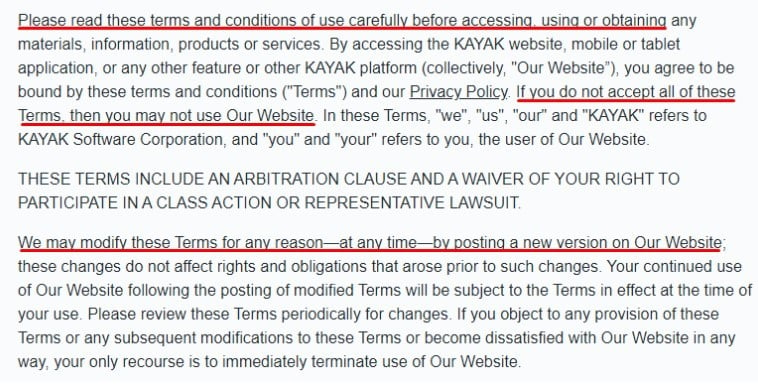
Instagram's Terms link is placed in the footer of its website:

Here's how Instagram places links to its Terms and Privacy information when users create a new account:
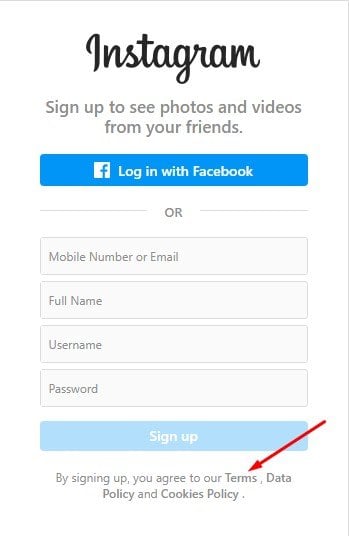
Below is an example of the Spotify Terms and Conditions Table of Contents. Note how the sections deal with topics such as "Rights we grant you," "User guidelines," "Choice of law, mandatory arbitration and venue" and "Term and termination":
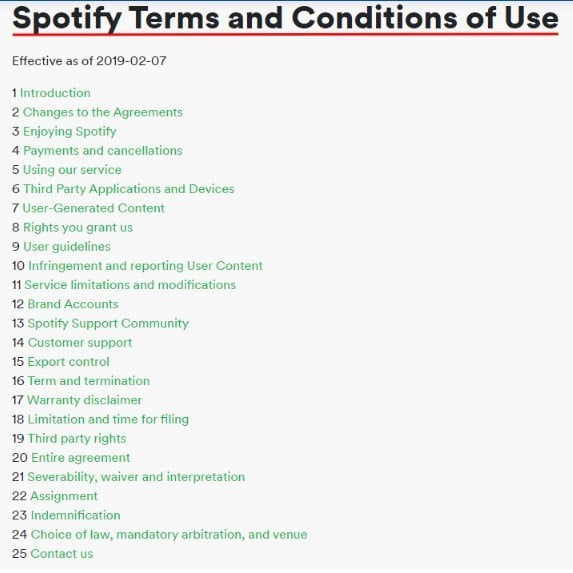
Perhaps the most important section of this legal document is the section that addresses how a user should use (or not use) your website and app.
In the Terms and Conditions of Spotify above, the User Guidelines section highlights a number of restricted user actions, including forbidding a user from:
This free Sample Terms and Conditions Template is available for download and includes these sections:
You can download the Sample Terms and Conditions Template as HTML code below. Copy it from the box field below (right-click > Select All and then Copy-paste) and then paste it on your website pages.
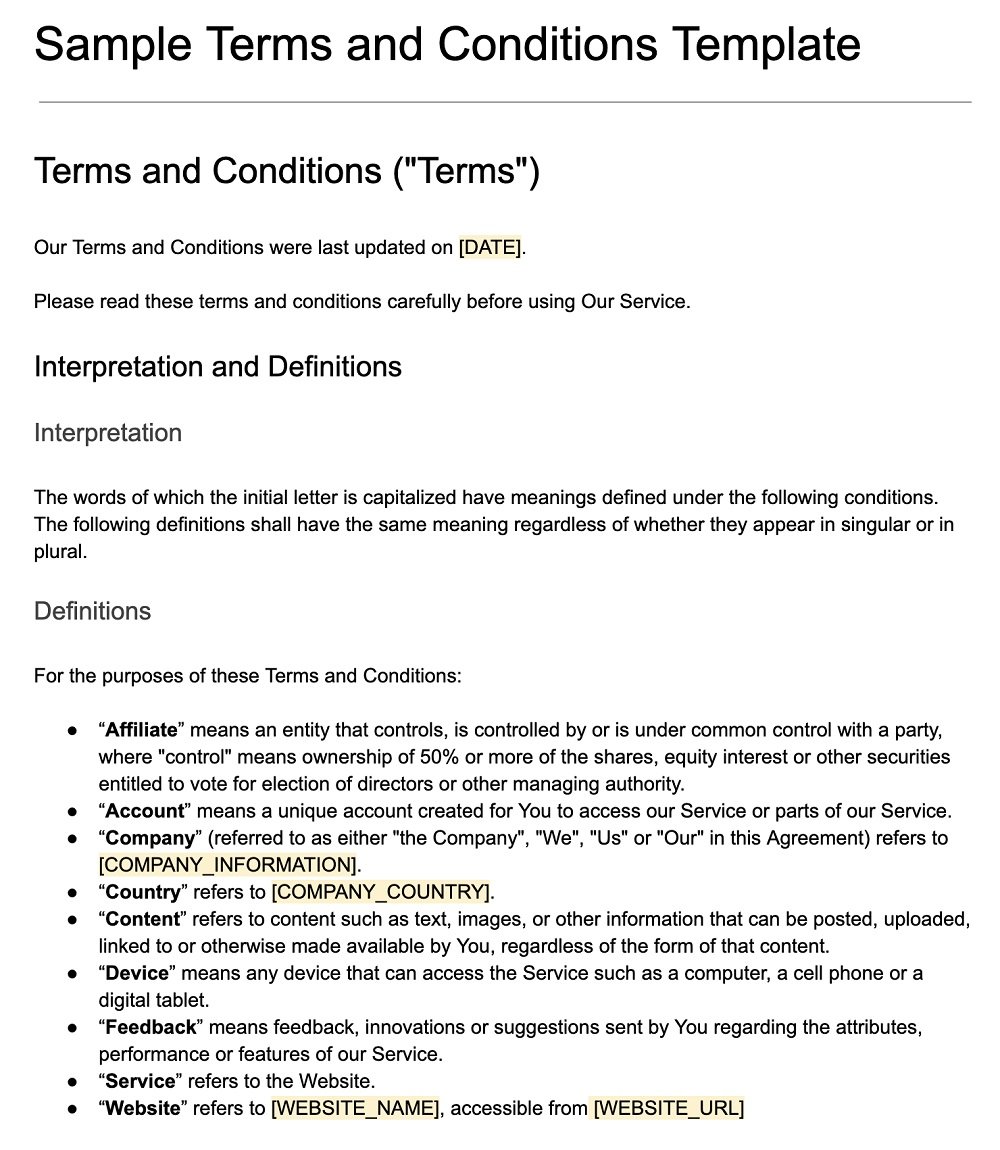
More specific T&Cs Templates are available on our blog.
| Sample Mobile App Terms and Conditions Template | A Terms and Conditions agreement for mobile apps. |
| Sample SaaS Terms and Conditions Template | A Terms and Conditions agreement for your SaaS business. |
| Small Business Terms & Conditions Template | A Terms and Conditions agreement for your Small Business. |
| Sample Ecommerce Terms & Conditions Template | A Terms and Conditions agreement for your Ecommerce Store. |
| Sample EULA Template | An End-User License Agreement for mobile apps. |
Comply with the law with our agreements, policies, and consent banners. Everything is included.
Disclaimer
This article is not a substitute for professional legal advice. This article does not create an attorney-client relationship, nor is it a solicitation to offer legal advice.
Last updated on
Appears in
Related articles
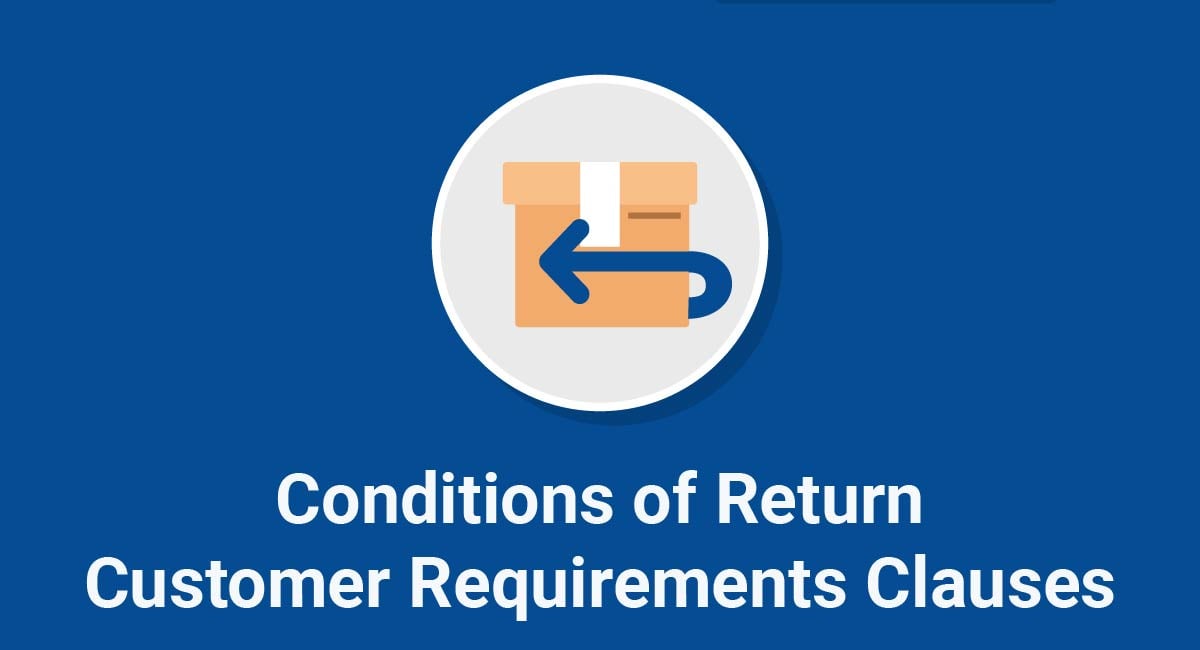
If you've ever tried to return a product or get a refund, you know how important it is that companies clearly lay out the requirements to get your money back. This information should be disclosed within a conditions of return and/or customer requirements clause. A clause like this is important for.
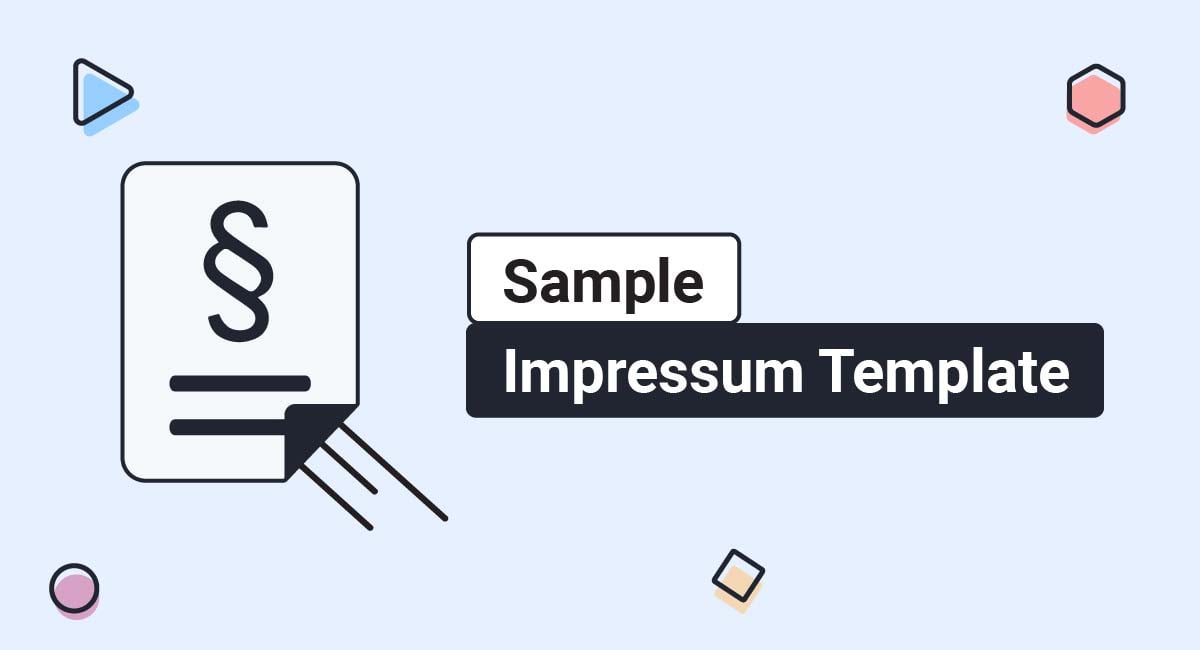
German-speaking countries such as Germany, Austria, and Switzerland legally require an Impressum to be included in any digital or print publications. For online business owners, an Impressum is a legal statement that divulges contact and copyright information to users. In this article we will explore what an impressum is, what exactly.
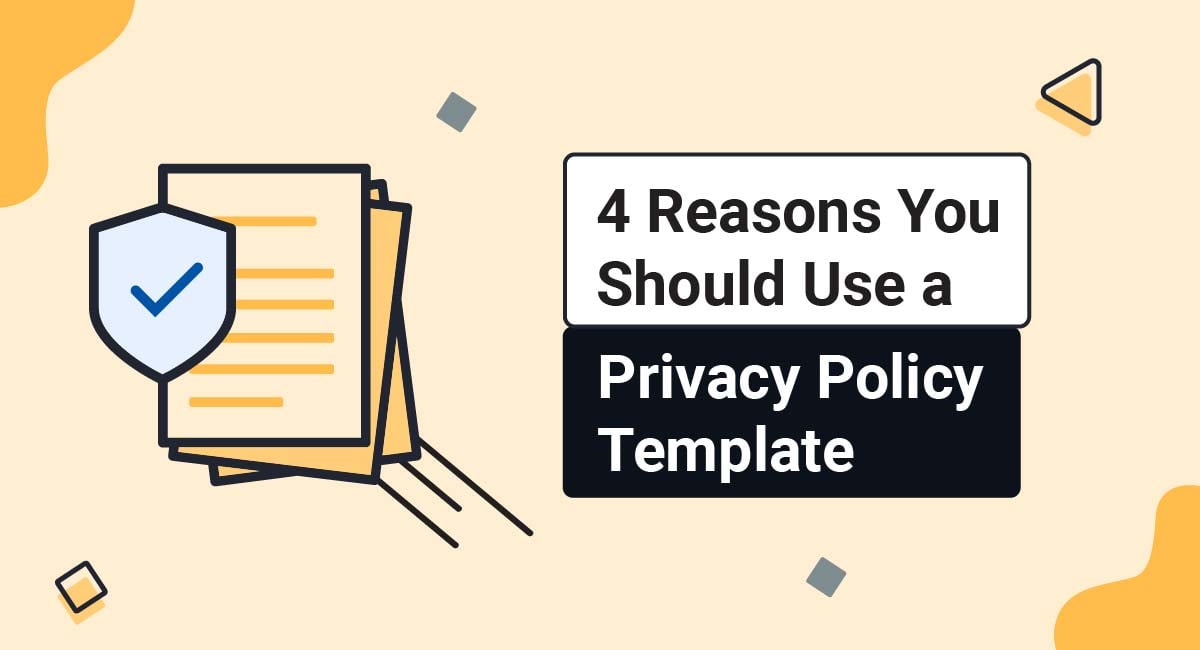
Privacy Policy templates are an effective, helpful tool that you can use to create a Privacy Policy for your website. They can provide you with detailed guidance while allowing full customization of a Privacy Policy, no matter what your business practices are or what industry you're in. This article will explain.
Comply with the law with our agreements, policies, tools and cookie consent banners. Everything you need is included.
Disclaimer: Legal information is not legal advice, read the disclaimer. The information provided on this site is not legal advice, does not constitute a lawyer referral service, and no attorney-client or confidential relationship is or will be formed by use of the site.
Copyright © 2012 - 2024 TermsFeed ® . All rights reserved.